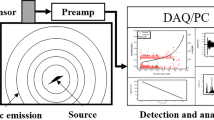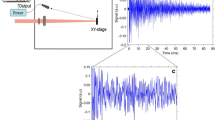Abstract
Acoustic Emission (AE) method proposed in this paper as a novel approach was used to evaluate residual stress in friction stir welding (FSW) of 5086 aluminum plates. A finite element method was used to evaluate residual stresses in aluminum plates caused by FSW, which was validated by the hole-drilling process. Moreover, fundamental antisymmetric Lamb wave mode (A 0) was implemented to measure the residual stresses produced by FSW process. The novelty of this investigation is the combination of a robust signal-processing analysis and theory of acoustoelastic Lamb wave. In this analysis, an envelope of A 0 mode is used instead of signal time of flight, which obliterates the need to utilize a synchronizing clock of receiving sensors. It was shown that the duration of the signal changes linearly with residual stress variation, and a new equation was then established. Finally, it is confirmed that AE as a nondestructive approach can be an efficient tool for residual stress measurement in welded plate.














Similar content being viewed by others
References
Totten G, Howes M, Inoue T (2002) Handbook of residual stress and deformation of steel. ASM International Materials Park, pp 11–15
Liu HJ, Fujii H, Maeda M, Nogi K (2003) Tensile properties and fracture locations of friction-stir-welded joints of 2017-T351 aluminum alloy. J Mater Process Technol 142:692–696
Guerra M, Schmidt C, McClure JC, Murr LE, Nunes AC (2002) Flow patterns during friction stir welding. Mater Charact 49:95–101
Bussu G, Irving PE (2003) The role of residual stress and heat affected zone properties on fatigue crack propagation in friction stir welded 2024-T351 aluminum joints. Int J Fatigue 25:77–88
Peel M, Steuwer A, Preuss M, Withers PJ (2003) Microstructure, mechanical properties and residual stresses as a function of welding speed in aluminum AA5083 friction stir welds. Acta Mater 51:4791–4801
Sadeghi S, Ahmadi Najafabadi M, Javadi Y, Mohammadisefat M (2013) Using ultrasonic waves and finite element method to evaluate through-thickness residual stresses distribution in the friction stir welding of aluminum plates. J Mater Des 52:870–880
Javadi Y, Sadeghi S, Ahmadi Najafabadi M (2014) Taguchi optimization and ultrasonic measurement of residual stresses in the friction stir welding. J Mater Des 55:27–34
Rossini NS, Dassisti M, Benyounis KY, Olabi AG (2012) Methods of measuring residual stresses in components. J Mater Des 35:572–588
Rose JL (2000) Guided wave nuances for ultrasonic nondestructive evaluation. IEEE Trans Ultrason Ferroelectr Freq Control 47(3):575–583
Dalton RP, Cawley P, Lowe MJS (2001) The potential of guided waves for monitoring large areas of metallic aircraft fuselage structure. J Nondestruct Eval 20(1):29–46
Croxford AJ, Moll J, Wilcox PD, Michaels JE (2010) Efficient temperature compensation strategies for guided wave structural health monitoring. J Ultrason 50:517–528
Michaels JE, Lee SJ, Michaels TE (2010) Effects of applied loads and temperature variations on ultrasonic guided waves. In: Proceedings of the European Workshop on Structural Health Monitoring, DES Tech Publications 1267–1272
Lu Y, Michaels JE (2009) Feature extraction and sensor fusion for ultrasonic structural health monitoring under changing environmental conditions. J IEEE Sens 9(11):1462–1471
Hughes DS, Kelly JL (1953) Second-order elastic deformation of solids. Phys Rev 92:1145–1149
Toupin RA, Bernstein B (1961) Sound waves in deformed perfectly elastic materials: acoustoelastic effect. J Acoust Soc Am 33:216–225
Husson D (1985) A perturbation theory for the acoustoelastic effect of surface waves. J Appl Phys 57(5):1562–1568
Qu J, Liu G (1998) Effects of residual stress on guided waves in layered media. Rev Prog Quant NDE 17:1635–1642
Rizzo P, Lanza di Scalea F (2003) Effect of frequency on the acoustoelastic response of steel bars. Exp Tech 27(6):40–43
Lematre M, Feuillard G, Delaunay T, Lethiecq M (2006) Modeling of ultrasonic wave propagation in integrated piezoelectric structures under residual stress. IEEE Trans Ultrason Ferroelectr Freq Control 53(4):685–696
Buffa G, Hua J, Shivpuri R, Fratini L (2006) A continuum based FEM model for friction stir welding-model development. Mater Sci Eng A 419:389–396
Huang NE, Shen Z, Long SR, Wu MC, Shih HH, Zheng Q, Yen NC, Tung CC, Liu HH (1971) The empirical mode decomposition and the Hilbert spectrum for nonlinear and nonstationary time series analysis. Proc R Soc Lond 454:903–995
King FW (2009) Hilbert Transforms, vol 1. Cambridge University Press, Cambridge
Gandhi N, Michaels J, Lee SJ (2011) Acoustoelastic Lamb wave propagation in a homogeneous, isotropic aluminum plate. AIP Conf Proc 1335:1–161
Thomas WM, Nicholas ED, Needham JC, Murch MG, Templesmith P, Dawes CJ (1991) Friction stir welding, International Patent Application No. PCT/GB92102203 and Great Britain Patent Application No. 9125978.8
ASTM E976–10 (2010) Standard guide for determining the reproducibility of acoustic emission sensor response. ASTM International, West Conshohocken
Buffa G, Ducato A, Fratini L (2011) Numerical procedure for residual stresses prediction in friction stir welding. Finite Elem Anal Des 47:470–476
Asadi P, Mahdavinejad RA, Tutunchilar S (2011) Simulation and experimental investigation of FSP of AZ91 magnesium alloy. Mater Sci Eng A 528:6469–6477
Xu W, Liu J, Zhu H (2000) Analysis of residual stresses in thick aluminum friction stir welded butt joints. J Mater Des 32:2000–2005
Acknowledgements
The authors wish to thank the Department of Mechanical Engineering at Amirkabir University of Technology, Tehran, the Islamic Republic of Iran, for providing the facilities for this study.
Funding
The author(s) received no financial support for the research, authorship, and/or publication of this article.
Author information
Authors and Affiliations
Corresponding author
Ethics declarations
Conflicts of interest
The author(s) declare that there are no potential conflicts of interest with respect to the research, authorship, and/or publication of this article.
Rights and permissions
About this article
Cite this article
Ahi, A.M., Yousefi, J., Najafabadi, M.A. et al. Residual stress evaluation in friction stir-welded aluminum plates using finite element method and acoustic emission. J Mater Sci 52, 2103–2116 (2017). https://doi.org/10.1007/s10853-016-0498-z
Received:
Accepted:
Published:
Issue Date:
DOI: https://doi.org/10.1007/s10853-016-0498-z




